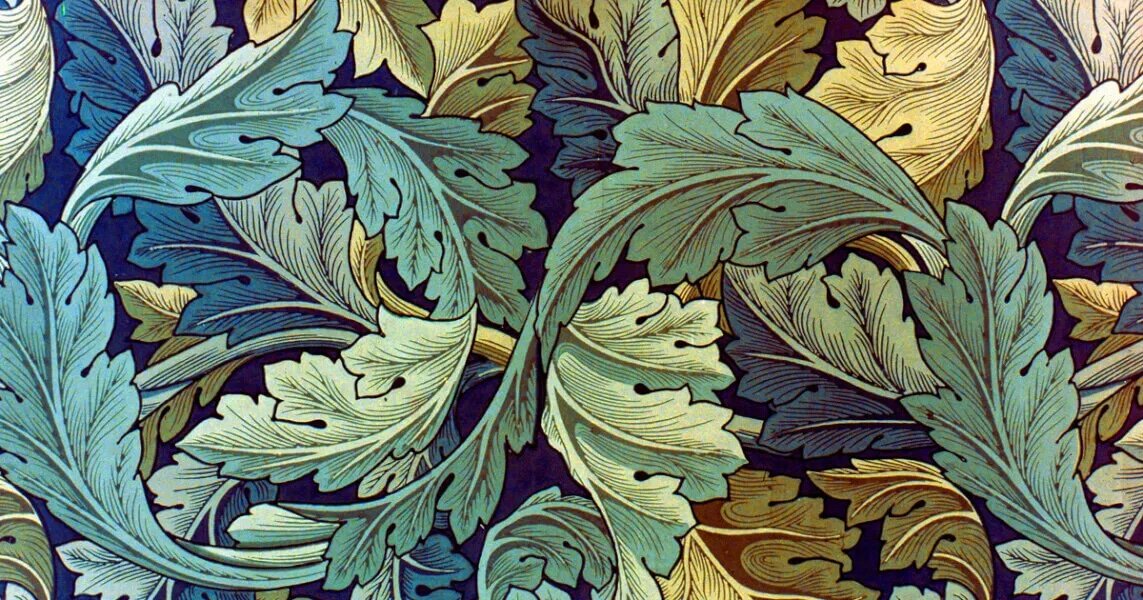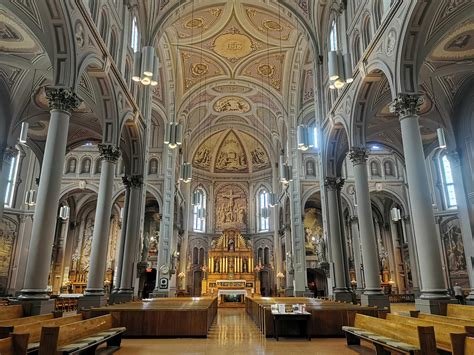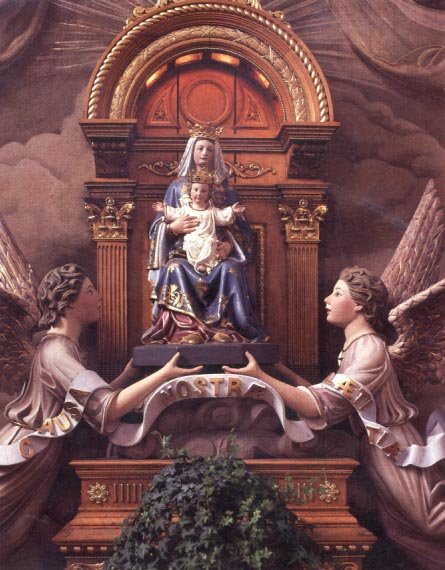
Our Lady of Liesse
From the Life of the Blessed Virgin Mary, with the History of Devotion to Her by Mathieu Orsini, translated from the French.
The pilgrimage to Our Lady of Liesse, in Picardy, not so old as those of the south of France, as it does not go farther back than the twelfth century, surpasses them in fame. The origin of the statue of the Blessed Virgin, which adorns this holy place, is very marvelous; the tradition has been preserved, not only in the province of France where it is found, but also in the Holy Land. We are even assured that it exists in the archives of the Knights of Malta. Here is the tradition, which bears a very decided Oriental stamp.
Foulques of Anjou, King of Jerusalem, having rebuilt the fortress of Bersabee, four leagues from Ascalon, to protect the frontier of his kingdom against the incursions of the Saracens, confided its care to the brave and pious knights of Saint John of Jerusalem. This valiant garrison was often engaged against the infidels who held the ancient country of the Philistines for the Sultan of Egypt.
One day, the knights of Saint John, among whom were three brothers of the ancient and opulent house of Eppes, in Picardy, fell into an ambush, and in spite of prodigies of valour, were taken and laden with chains by the Muslims, who sent them into Egypt. The gentlemen of Eppes had the lofty mien, the tall stature, and the heroic bearing of the ancient nobles of the north of France.
The Sultan at once singled them out, and, desirous of gaining them over to his false prophet, began by throwing them into a dungeon to weaken their courage. He held before their eyes afterwards the most enticing prospects, in order to draw them into apostasy.
The three warriors, who had been inaccessible to fear, were deaf to the noise of gold and the voice of ambition. The Sultan, deceived in his expectations, sent to them the most celebrated imams, to argue with them upon faith. The good knights, through disgust of Islam, became all at once subtle theologians, and defended Christianity as well in dispute as they had often done with the shield on their arm and the lance in their grasp.
The Sultan considered himself bound in honour to vanquish the captives, and his opposition increased with their resistance. He swore that the Knights of Saint John should follow the standard of the prophet, even if it should cost him the half of Egypt. He had a daughter, handsome, chaste, accomplished, and every way worthy to follow a better faith; he sent her to the dungeon where the French knights were languishing in fetters, and charged her to set before them a frightful picture of the punishments prepared for them.
The knights received the princess with those testimonies of respect which were at that time lavished upon ladies; but they repelled her insinuations with the resolute courage of men who accept of martyrdom, and explained to her their belief in a manner so persuasive that the Muslim lady betook herself to serious reflection on Christ and His Blessed Mother.
A miraculous and resplendent image of Mary, Our Lady of Liesse, which, it is said, was brought by angels to the pious champions of the Christian faith, completed the conversion of the young infidel. One night, when she had gained over the guards of the three French warriors by bribes of gold, she made her way into their prison with a casket full of precious stones, and made her escape with them from her father’s palace.
After passing the Nile in a boat prepared for their reception, the fugitives directed their course towards Alexandria, hoping, perhaps, to conceal themselves for a time in the Coptic monasteries of the desert of Saint Macarius. But, after marching for some hours, the princess, exhausted with fatigue, wished to rest for a little while, and, in spite of the imminent danger, the three knights of Saint John, determined to keep good guard, made her sit down in a field of doura in full verdure, and seated themselves at a respectful distance. The princess fell asleep, and her travelling companions, after struggling in vain against the drowsiness which followed long nights without rest, slept soundly also.
No one knows how long their slumber continued. The knight of Eppes, the eldest of the three, was the first who awoke; the sun was beginning to gild the tops of the trees, where he heard the sweet singing of birds. The crusader looked at the landscape with great surprise: he had gone to sleep in sight of the Nile and the pyramids, under the fan-like branches of a palm-tree, and he awoke beneath an oak, with knotty branches, on the margin of a clear spring, on the freshest turf, sprinkled with white daisies.
A short distance off, the round and dark towers of an old baronial castle reminded him of the manor where he had left his mother, all in tears at his departure for the Holy Land. A shepherd, who was driving his sheep to the fields, relieved him of his perplexity; the castle which he beheld was in fact his own castle of Marchais, and he awoke in Picardy, beneath the avenue which his fathers had planted. He blessed the Holy Virgin, and awakened his companions, whose astonishment was as great as his own.
They had preserved the image of the oriental Madonna; they built a handsome church to receive Our Lady of Liesse, and the Muslim princess received baptism in the cathedral of Leon.
We may innocently believe that this little statue of Mary came into France by more natural means; but what it is impossible to doubt is that it was brought from the Holy Land by three great men of Eppes, knights of Saint John of Jerusalem.
The most illustrious names of the monarchy figure in the list of pilgrims to Our Lady of Liesse. We read there those of the Duke of Burgundy, Louis II of Bourbon, Prince of Conde, Duke of Mercoeur, of Prince Albert Hermy of Ligne, of Madame Henriette Françoise of France, Queen of England, of the princes of Longueville, of Marshal D’Ancre, of Mademoiselle de Guise, of the Count D’Egmont, of Louis, Duke of Orleans, brother of Charles VI, of Charles VII, of King Rene, Of Louis XI, of Francis I, of Henry II, of Charles IX, of Queen Mary of Medicis, of Louis XIII, of Anna of Austria, of Louis XIV.
Several of these great personages, not satisfied with leaving rich presents to Our Lady of Liesse, placed their statues there: that of Louis II of Bourbon, Prince of Conde, was of gold. Mary D’Arquin, then grand Marshal of Poland, and who was afterwards queen of that kingdom, came to the chapel of Our Lady in 1671; she offered to the Blessed Virgin a child in silver, representing the Prince Alexander Sobieski, her son, with a golden chain enriched with diamonds, to testify that she devoted him to the Mother of God, as her slave.
This sanctuary was pillaged like the others by the Protestants; the Revolution came to glean whatever was left.
The chapel of Our Lady of Liesse still attracts today a great concourse of pilgrims.
Do You Know Our Lady of Liesse? by Marie Baboyant
An article on devotion to Mary cannot be out of place with Kateri. Especially if this devotion is linked to the Jesuits. Indeed, we know that Kateri knew the Virgin Mary during her preparation for her baptism, during the winter of 1675-1676. “She had a tender devotion to the Mother of God, writes Father Claude Chauchetière, as soon as she was taught the qualities, the power and the glory of Our Lady and how to honour her.” And then she recited all her life “Wari, tekonnoronkwanions”, the “Hail Mary” in the beautiful language of Mohawks. The Angelus also and the litanies of the Blessed Virgin, which she knew by heart.
In order to imitate Kateri's Marian devotion, I have no doubt that you are ready to take an interest in anything that can bring you closer to the Virgin Mary, including her shrines. Do you know, for example, that of Our Lady of Liesse? It is possible not, because this is one of his most discreet places of prayer.
The home of Our Lady of Liesse in Canada is the Church of Gésù, in the centre of Montréal, on Rue de Bleury between Dorchester and Sainte-Catherine. It is a beautiful old church, built in 1863-1865 as the church of the College Sainte-Marie, of the Jesuit Fathers, which had already existed since 1848. It is baroque in style, the only one of this style in Montréal. This means in particular that it has very tall and large columns, an entire decoration of monochrome brown frescoes, that the altars are decorated with very high altarpieces. All of this creates a very good climate for prayer.
Eglise du Gésù, Montréal
The statue of Our Lady of Liesse sits on the altar in the south transept, to the left of the central altar. It has been there for a century this year, since 7th September, 1877. It was the Jesuits, Father François-de-Sales Cazeau more especially, who brought it there. Since then, she has been surrounded by votive offerings, lights and the faithful, who pray to her and obtain from her many spiritual favours, especially spiritual joy, as the name under which Mary is invoked here. And throughout history, brilliant miracles have happened in front of this statue of the Virgin.
Our Lady of Liesse in France
It is in an old church built in 1115 15 kilometres from Laon that worship begins. A black statue of the Virgin, “in coffee-coloured wood”, say the old texts, was brought there by knights returning from the Crusades. They are three brothers, from the family of Eppes and Marchais, belonging to the order of Hospitallers, today Knights of Malta. And they bring back with the miraculous statue a beautiful legend.
Well abbreviated, the legend says this: in 1134, the Knights pushed the Muslims out of Jerusalem, to Ascalon. Despite this victory, the three knights were taken prisoner by the Sultan and brought to Cairo. The Sultan tried by all means to convert them to Islamism. And as a last means, he sends them one of his daughters, Princess Ismeria, to seduce them. The knights resisted and in turn tried to convert her to Christianity. And they prayed the Virgin Mary to help them make a statue of her to present it to Ismeria. They even asked for wood and tools that the princess brought to them.
However, even before they have tried to create an image, when they woke up they found a beautiful statue of the Virgin. She converted Princess Ismeria, who fled with the knights, and eventually arrived on their family's land, near Laon. The image suddenly became so heavy that no one was able to transport it afterwards. We saw there the sign that she wanted to have her sanctuary there. Which was done. And Princess Ismeria, who became a Christian, lived there and died after a holy life. In particular, the Knights of Malta honoured her with a special cult.
The Adventurous Story of Our Lady of Liesse
The church quickly became a place of pilgrimage. Many people came there to pray in front of the black statue. Among them, kings: Charles VI in 1414, Louis XI several times, Marie de Medici to thank the Virgin for the birth of Louis XIII, Louis XIV in 1652.
But then came the French Revolution and looting. The ex-votos were stolen in 1790 and 1792. Then, in 1793, during a new rampage, the statue was transported out of the church and burned. Pilgrimages were prohibited and the church remained deserted.
But the faithful had collected the coals from the burnt statue. In 1802, peace having returned, the pilgrimage began again. One of the parish priests found a small stone statue of the Virgin in the attics. He surrounded the coals of the old statue in cardboard, fixed the stone head above it and exhibited it to pilgrims. As the miracles began again, the church was gradually renovated, a new statue similar to the old one was made in 1857, and some fragments of the coals were inserted into it. It is this statue which is still venerated today in Liesse near Laon.
The Jesuits, who have served the church since 1851, had kept in their house the old cardboard statue with the burnt fragments. They commission a craftsman from Paris to make a statue that reproduces the poor image of cardboard and stone in a more solid way. It remained with them until the spring of 1877, when the French government requisitioned the Jesuits' residence and forced them to leave for Paray-le-Monial.
Our Lady of Liesse in Québec
It is now that we meet the Canadian Jesuits who were doing their Third Year of Novitiate at Liesse. The superior of the house, shortly before their return to Canada, decided to give them the old statue of Our Lady of Liesse, containing the ashes of the statue burnt in 1793, so that it could have a sanctuary in Montreal. This is how it is brought to the Gésù. The fervour with which she was greeted very quickly brought about a response from Mary by various favours. The following year, on 7th January 1878, all the bishops of Canada, gathered for the opening of the Faculties of Laval University in Montréal, came to pray to her. And on 31st May of the same year, the bishop of Montreal, Mgr Fabre, ended the month of Mary by solemnly enthroning the statue. Shortly after, he obtained the indult which granted a special mass and an office in the breviary, fixing the feast on 1st June. In his Christmas circular letter 1878, he recounted the legend of the three knights and Princess Ismeria. And as early as 1879, three more brilliant miracles were told.
From the Kateri Journal
Our Lady of Liesse statue in Montréal




